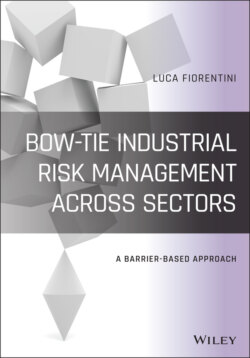Читать книгу Bow-Tie Industrial Risk Management Across Sectors - Luca Marmo, Luca Fiorentini - Страница 23
Acknowledgements
ОглавлениеFirst of all, I would like to express my thanks to Rosario Sicari, director of Chaos Consulting (www.chaosconsulting.it), with whom I share an important personal friendship as well as many professional interests, including accident investigation, forensic engineering and, especially, risk management with the barrier‐based methods shown in this volume. Rosario, with his impressive analytical skills combined with a broad knowledge of risk analysis methods and risk management principles, guarantees an important and constructive daily confrontation that allows, together with a communion of intent and in complete operational harmony, to operate successfully in support of clients for a consulting activity oriented to complexity management. With him I shared the adventure of this book on methodologies that are much appreciated by both of us, discovering a skilled technician, a patient detail curator and reviewer, and a determined critic. Of course, as I have in the past, I will enjoy sharing with him some other engaging professional experiences and business opportunities.
I also would like to thank Damiano Tranquilli. He gave important support in the description of the proactive and reactive risk management culture that complex organizations should adhere to (ref. par. 1.6). He is a very good friend of mine and this friendship was born at the margins of a number of Bow‐Tie brainstorming sessions related to the use of the method to define priorities for risk reduction measures to be implemented in some very complex railway stations following a long period of fire risk audits to verify fire strategies, fire regulation compliance, fire prevention and protection measures, and assets’ future developments. Our project Bow‐Ties, with me as a consultant and Damiano representing the customer, made me discover some of his unique qualities: he is very pragmatic and able to deal with complexity coming from the multiple, intercorrelated processes of very large companies, in a fascinating manner and without any apparent efforts. He is the “management systems man” since he knows how to design, implement, review new organizational processes, and assess the associated risks, with the precise “risk‐based thinking” underlined by this book. I have to admit that I took advantage of his particular propension to a systemic and risk‐based approach in many cases as a friendly personal consultant and I appreciated, for this book, his preface and his help in the chapter dedicated to complex organizations, which he masters very well.
A heartfelt thank you to CGE Risk for the valuable support offered in the writing of this book, for the many examples and for their beautiful images that make us appreciate even more the beauty of the Bow‐Tie, as well as its usefulness for use in various business sectors. For this reason, as I am unable to thank the entire CGE Risk team by name, my thanks go in particular to Jeroen van Dommelen, Iris Curfs, and Geert van Loopik, who I ask to extend my recognition to their valuable collaborators for everything we have done together so far and for what we will do in the future. Barrier‐based methodologies discussed in this volume are challenging to apply to real‐world cases where complexity should be described; CGE Risk is the leader in barrier‐based software tools supporting these methods, giving the users a number of possibilities to be successful in engaging risk assessment in order to focus on the elements, on the relationships and, of course, on the outcomes of the risk assessment rather than on the drawing part that, in some cases, with traditional non‐risk‐oriented tools, could be a cumbersome experience, with the ability to also obtain a pretty advanced user interaction and clear colourful diagrams. I thank CGE Risk very much for having granted me the chance to use their tools to develop the pictures and examples of this book, giving the reader a uniform and consistent visual experience from the principles to the explanations to the examples and case studies. Their tools deserve a try!
Finally, my thanks go to those who have contributed to providing valuable examples of the methodologies described in this book. These are professionals from different business contexts, demonstrating the universal applicability of the methods discussed here. Therefore, I would like to thank: Bernardino Chiaia and Valerio De Biagi from Politecnico di Torino; Ian Travers from Ian Travers Limited; Jasper Smit from Slice; Tor Inge Saetre from AdeptSolutions; Salvatore Tafaro from the Italian National Fire Brigade; Emily Harbottle from Harbottle Hughes Risk Management; Ed Janseen; Arthur Groot, Process Safety Expert – Royal Haskoning DHV; David Hatch, process safety expert; Orazio Cassiani, risk manager in the healthcare sector; Prof. Luca Marmo from Politecnico di Torino; Paul Heimplaetzer; Annalisa Contos from Atom Consulting; Domenico Castaldo from TIM S.p.A.; Luca Toncelli and Francesco Fanelli from Human Factor Italia. I thank them very much for their efforts in giving some examples of barrier‐based methods from their own sectors, giving valuable impressive content of real applications that enrich the volume in a way the reader can find immediate applications of the risk terms and definitions, principles from different perspectives, allowing also to take some ideas out the pages to start creating their first Bow‐Ties or benchmark those they already have with some of the greatest barrier‐based risk management experts from different countries I had the chance to meet during my professional experiences.
